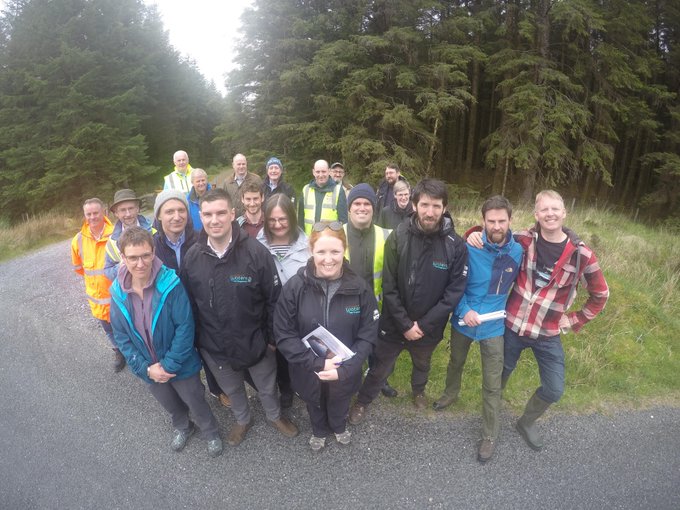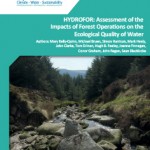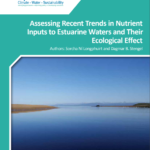The EPA has published the results of the HYDROFOR research…
The Blue Dot Catchments Programme
Cormac Mc Conigley, the newly appointed Blue Dot Scientist with the Local Authority Waters Programme, tells us about the first 6 months of the Blue Dot Catchments Programme, which aims to protect and restore high status waters in Ireland.
Across Europe, the protection of high status sites has not been highlighted as a key issue, and no known effective programmes of measures have been implemented elsewhere specifically for the protection or restoration of high ecological status water bodies. Ireland, still retains many of these sites, a total of 17.6% according to the latest RBMP (Government of Ireland, 2018). Comparable proportions in Europe are only found in Alpine areas (Austria: 20%) and Nordic countries (Sweden: 12%, Finland 16%). Neighbouring countries and many central European countries have few left: UK: 3%, Germany: 0.1% and Poland 0.5% (www.eea.europa.eu).
Ireland has recognised the need to be a European leader in the development of protection and restoration measures focussed on high status waters, and has firmly indicated in the 2nd cycle RBMP the prioritisation of high status waters.
The second-cycle River Basin Management Plan (RBMP) was published by the Minister for Housing, Planning and Local Government in April 2018. Ireland undertook a comprehensive re-characterisation of its waters as part of its preparations. The Plan set a high status environmental objective for 319 river water bodies, 37 lakes, 12 transitional water bodies and 16 coastal water bodies. 63% of these water bodies are currently achieving their high status environmental objective, with 33% confirmed through characterisation as being At Risk, while 4% require further assessment or monitoring to assess their risk profile. The longterm trend of decline in the number of high-status river sites was confirmed as continuing.
The EPA produces national water quality reports every three years and these have defined a trend in loss of pristine and high status sites. High status sites have declined from 31.5% (1987-1990) to 17.6% (2013-2015) an almost 50% loss (Fanning et al., 2017).
Particularly concerning is the decrease in the numbers of sites that were considered of the highest status, which score a Q5. In the 1980s, Q5 sites made up 13.4% of all monitored sites; now only a small minority of the monitored sites are at Q5 (0.7%). The decline in the status of these sites must be halted, and then reversed if we are to achieve our WFD objectives.
The RBMP 2018-2021, sets out the targets and measures Ireland will implement to achieve the objectives of the WFD. One of the key measures to address the decline in high status waterbodies is the setting up of the Blue Dot Catchments Programme and associated Steering Group to specifically target the maintenance and restoration of high status waterbodies. The Programme is directed by a Blue Dot National Steering Group which had its inaugural meeting in January 2019. The Steering Group is chaired by John Breen, Director of Services for Water, Environment, Fire and Library Services in Kerry County Council and is made up of representatives from many of the organisations with an interest in high status waterbodies.
| Blue Dot Working Group |
| Local Authority Waters Programme |
| Department of Housing, Planning and Local Government |
| Kerry County Council |
| Wicklow County Council |
| Donegal County Council |
| Mayo County Council |
| Coillte |
| Department of Agriculture, Food and the Marine – Agriculture & Forest Service |
| Environmental Protection Agency |
| Irish Water |
| National Parks and Wildlife Service |
| Office of Public Works |
The Steering Group met three times between January and May 2019. The first 2 meetings were focused on assisting with the DHPLG bid for a LIFE Integrated Project “Waters of LIFE”. The third meeting included a half day field trip to the Owenriff Priority Area for Action which includes high status objective water bodies, followed by a meeting to present proposals for key targets for inclusion in a draft Blue Dot Catchments Programme work programme for discussion and input from the group.
Waters of LIFE Integrated Project
The LIFE Integrated Project (IP) “Waters of LIFE” aims to support the implementation of measures to protect and enhance high status waters and thus support the work of the Blue Dot Catchments Programme. The project, if successful, will act as a catchment-scale demonstration project to test and validate the effectiveness of implementing locally-tailored ‘best practice’ measures across a range of land uses typically seen in the catchments of high-status waters. The project will trial and validate the implementation of measures at the catchment scale across a number of pilot catchments with the view to building national capacity, optimising approaches for the targeting of measures in critical areas of the catchment, assessing the effectiveness of the approaches and using the learnings from the project to inform and support ongoing work across all high status catchments. If successful the project will have a budget of approximately €20 million, with over half coming from organisations in Ireland that are beneficiaries. The LIFE bid was successfully submitted in March and is being reviewed by the European Commission.

Blue Dot fieldtrip
Since the submission of the LIFE IP bid the working group has continued to advance the drafting of the Blue Dot Catchments Programme. In May a fieldtrip was undertaken to the Owenriff Priority Area for Action in County Galway, where the Steering Group had the opportunity to experience first-hand some of the issues that impact high status waterbodies and to discuss potential solutions. The group visited a wastewater treatment plant; a high status lake; an area of old forestry plantations and a river site that is hydromorphologically impacted. At each location a discussion was led by a member of LAWPRO, Irish Water, NPWS, EPA, Coillte or the Forest Service. The fieldtrip successfully allowed the group to deepen their understanding of the issues that affect high status waterbodies and provided an opportunity for learning between members.
Blue Dot work programme
Following the fieldtrip, the working group met to define a draft work programme. A proposal outlining key targets the draft work programme should prioritise was prepared by reviewing key literature and documents relating to high status waters, in particular the EPA STRIVE funded project 2010-W-DS-3 which delivered a discussion document titled Management Strategies for the Protection of High Status Water Bodies (Ní Chatháin et al., 2012).
The most commonly recommended priorities from the review were:
- To work with communities promoting and supporting the establishment of community led catchment initiatives in Blue Dot catchments.
- Planning/Licensing control and assessment of cumulative impacts.
- Influencing national schemes and programmes (e.g. DWWTS grant scheme; Native Woodlands Scheme; Agri-environmental schemes etc.).
- Improving the exchange of information within and across public authorities and Government Departments, to monitor activities on an ongoing basis in Blue Dot catchments.
- Identify areas for further research related to the protection and restoration of Blue Dot catchments.
There was broad agreement that these 5 priorities would serve as an suitable starting point for the work programme. In the coming months, the work programme will be drafted and presented for review to the Steering Group and other bodies for feedback. The Programme is also being highlighted at Regional Operational Committee and Management Committee meetings under the Local Authority governance structures for implementation of the WFD. LAWPRO have also formed an internal Blue Dot working group comprised of staff across the programme, with a view to supporting the role of the Blue Dot Scientist and developing guidance on local catchment assessments in high status objective water bodies.
Cormac McConigley, Blue Dot Scientist, Local Authorities Water Programme, and Bernadette White, Catchment Manager – Western Region, & Blue Dot Catchments Programme Manager, Local Authorities Water Programme
Learn more:
Management Strategies for the Protection of High Status Water Bodies (2012)
The EPA has highlighted, as a key concern, the decline in high ecological quality river sites. Such waters are indicators of largely undisturbed conditions and reflect natural background status or only minor distortion by human influences. The EPA commissioned research in this area to review existing legislation relevant to the protection and management of high status sites review international best practice on protecting these sites; and recommend new approaches to ensuring that high status water bodies remain at high status. The report, originally published in 2012, proposes key strategies to protect & manage high status waters.







